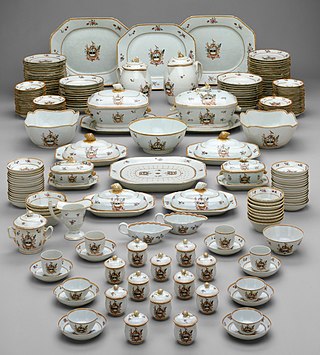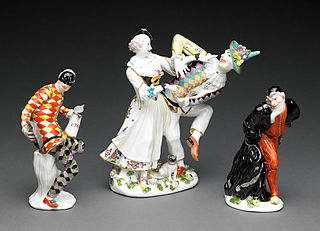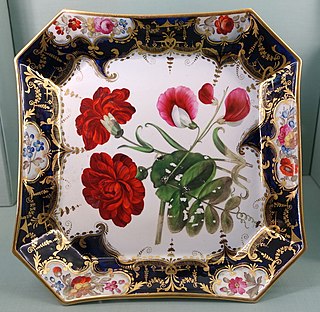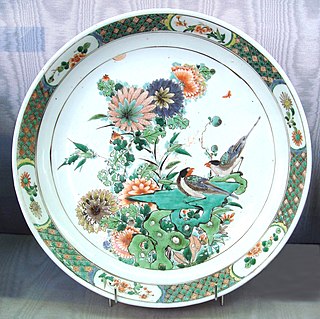Related Research Articles

Porcelain is a ceramic material made by heating raw materials, generally including kaolinite, in a kiln to temperatures between 1,200 and 1,400 °C. The greater strength and translucence of porcelain, relative to other types of pottery, arise mainly from vitrification and the formation of the mineral mullite within the body at these high temperatures. End applications include tableware, decorative ware such as figurines, and products in technology and industry such as electrical insulators and laboratory ware.

Faience or faïence is the general English language term for fine tin-glazed pottery. The invention of a white pottery glaze suitable for painted decoration, by the addition of an oxide of tin to the slip of a lead glaze, was a major advance in the history of pottery. The invention seems to have been made in Iran or the Middle East before the ninth century. A kiln capable of producing temperatures exceeding 1,000 °C (1,830 °F) was required to achieve this result, the result of millennia of refined pottery-making traditions. The term is now used for a wide variety of pottery from several parts of the world, including many types of European painted wares, often produced as cheaper versions of porcelain styles.

The Wallace Collection is a museum in London occupying Hertford House in Manchester Square, the former townhouse of the Seymour family, Marquesses of Hertford. It is named after Sir Richard Wallace, who built the extensive collection, along with the Marquesses of Hertford, in the 18th and 19th centuries. The collection features fine and decorative arts from the 15th to the 19th centuries with important holdings of French 18th-century paintings, furniture, arms and armour, porcelain and Old Master paintings arranged into 25 galleries. It is open to the public and entry is free.

Kuskovo was the summer country house and estate of the Sheremetev family. Built in the mid-18th century, it was originally situated several miles to the east of Moscow but now is part of the East District of the city. It was one of the first great summer country estates of the Russian nobility, and one of the few near Moscow still preserved. Today the estate is the home of the Russian State Museum of Ceramics, and the park is a favourite place of recreation for Muscovites.

Chinese export porcelain includes a wide range of Chinese porcelain that was made (almost) exclusively for export to Europe and later to North America between the 16th and the 20th century. Whether wares made for non-Western markets are covered by the term depends on context. Chinese ceramics made mainly for export go back to the Tang dynasty if not earlier, though initially they may not be regarded as porcelain.

Chelsea porcelain is the porcelain made by the Chelsea porcelain manufactory, the first important porcelain manufactory in England, established around 1743–45, and operating independently until 1770, when it was merged with Derby porcelain. It made soft-paste porcelain throughout its history, though there were several changes in the "body" material and glaze used. Its wares were aimed at a luxury market, and its site in Chelsea, London, was close to the fashionable Ranelagh Gardens pleasure ground, opened in 1742.

Meissen porcelain or Meissen china was the first European hard-paste porcelain. Early experiments were done in 1708 by Ehrenfried Walther von Tschirnhaus. After his death that October, Johann Friedrich Böttger continued von Tschirnhaus's work and brought this type of porcelain to the market, financed by Augustus the Strong, King of Poland and Elector of Saxony. The production of porcelain in the royal factory at Meissen, near Dresden, started in 1710 and attracted artists and artisans to establish, arguably, the most famous porcelain manufacturer known throughout the world. Its signature logo, the crossed swords, was introduced in 1720 to protect its production; the mark of the swords is reportedly one of the oldest trademarks in existence.

Royal Worcester is a porcelain brand based in Worcester, England. It was established in 1751 and is believed to be the oldest or second oldest remaining English porcelain brand still in existence today, although this is disputed by Royal Crown Derby, which claims 1750 as its year of establishment. Part of the Portmeirion Group since 2009, Royal Worcester remains in the luxury tableware and giftware market, although production in Worcester itself has ended.

The Vladimir Palace is the former palace of Grand Duke Vladimir Alexandrovich of Russia, son of Alexander II. It was one of the last imperial palaces to be constructed in Saint Petersburg, Russia. It was designed by a team of architects including Vasily Kenel, Aleksandr Rezanov, Andrei Huhn, Ieronim Kitner, Vladimir Shreter and Maximilian Messmacher. Construction work on the waterfront lasted from 1867 to 1872, additional construction and extensions continued in the 1880s and 1890s. Major restorations were made in the 1980s and in 2010.

Capodimonte porcelain is porcelain created by the Capodimonte porcelain manufactory, which operated in Naples, Italy, between 1743 and 1759. Capodimonte is the most significant factory for early Italian porcelain, the Doccia porcelain of Florence being the other main Italian factory. Capodimonte is most famous for its moulded figurines.

The Imperial Porcelain Factory, also known as the Imperial Porcelain Manufactory, is a producer of hand-painted ceramics in Saint Petersburg, Russia. It was established by Dmitry Ivanovich Vinogradov in 1744 and was supported by the Russian tsars since Empress Elizabeth. Many still refer to the factory by its well-known former name, the Lomonosov Porcelain Factory.

Doccia porcelain, now usually called Richard-Ginori, at Doccia, a frazione of Sesto Fiorentino, near Florence, was in theory founded in 1735 by marchese Carlo Ginori near his villa, though it does not appear to have produced wares for sale until 1746. It has remained among the most important Italian porcelain factories ever since.

Dulyovo porcelain works is a Russian porcelain manufacturer based in the Moscow Oblast. Its products are better known as Dulevo porcelain. The works were founded in the Dulyovo wasteland in 1832 by merchant Terenti Kuznetsov from Gzhel.

Gzhel is a Russian style of blue and white ceramics which takes its name from the village of Gzhel and surrounding area, where it has been produced since 1802.

French porcelain has a history spanning a period from the 17th century to the present. The French were heavily involved in the early European efforts to discover the secrets of making the hard-paste porcelain known from Chinese and Japanese export porcelain. They succeeded in developing soft-paste porcelain, but Meissen porcelain was the first to make true hard-paste, around 1710, and the French took over 50 years to catch up with Meissen and the other German factories.

The Porcelain Museum is located in the Casino del Cavaliere, one of the highest points of the Boboli Gardens at the Pitti Palace in Florence, Italy.

Coalport, Shropshire, England was a centre of porcelain and pottery production between about 1795 and 1926, with the Coalport porcelain brand continuing to be used up to the present. The opening in 1792 of the Coalport Canal, which joins the River Severn at Coalport, had increased the attractiveness of the site, and from 1800 until a merger in 1814 there were two factories operating, one on each side of the canal, making rather similar wares which are now often difficult to tell apart.

China painting, or porcelain painting, is the decoration of glazed porcelain objects, such as plates, bowls, vases or statues. The body of the object may be hard-paste porcelain, developed in China in the 7th or 8th century, or soft-paste porcelain, developed in 18th-century Europe. The broader term ceramic painting includes painted decoration on lead-glazed earthenware such as creamware or tin-glazed pottery such as maiolica or faience.

Vienna porcelain is the product of the Vienna Porcelain Manufactory, a porcelain manufacturer in Alsergrund in Vienna, Austria. It was founded in 1718 and continued until 1864.

Rostov Kremlin - is a National museum-reserve situated in Rostov, Yaroslavl Oblast, Russian Federation. Museum-reserve preserves the architectural ensemble of the Rostov Kremlin, Church of St. John the Evangelist (1687) on Ishnya river, and has got different branches within the Rostov municipal district. The only museum of national level in the Yaroslavl region. Museum was founded in 1883 and now is a huge scientific center for the study of archaeology, architecture, art, and history. Museum has got vast collections of archeology, ancient Russian art, modern and contemporary art, decorative and applied arts, numismatics, photos, bells, enamel and ecclesiastical art.
References
- ↑ Ross, M. C. (1968). Russian porcelains: the Gardner, Iusupov, Batenin... and Kuznetsov factories: the collections of Marjorie Merriweather Post, Hillwood, Washington, DC. University of Oklahoma Press.
- ↑ Piper, R. F., Carter, C. L., Sawkins, A., Odom, A., Kettering, K. L., & Krizenesky, E. (2001). At the Tsar's Table: Russian Imperial Porcelain from the Raymond F. Piper Collection. Exhibition Catalogs and Pamphlets, 18.
- ↑ Ganiyeva, F. (2023). Porcelaine of Eastern and Western Lifestyles: Similarities and Differences. Vakanüvis-Uluslararası Tarih Araştırmaları Dergisi, 8(2), 1513-1531.
- ↑ Floor, Willem, and Jaap Otte. "European ceramics in Iran in the 19th and early 20th centuries." American Ceramic Circle (2019): 117-143.